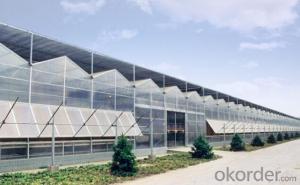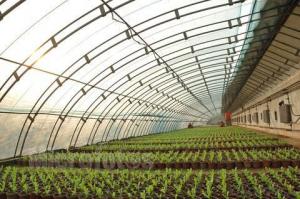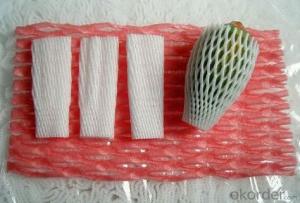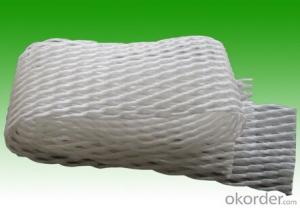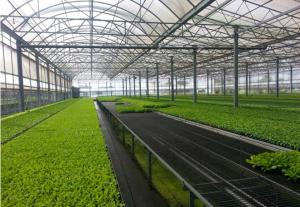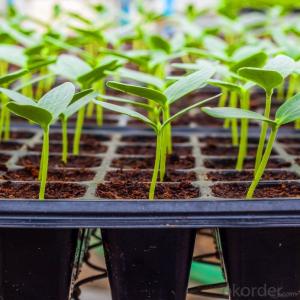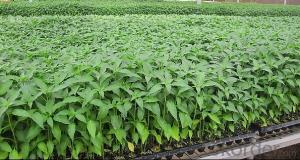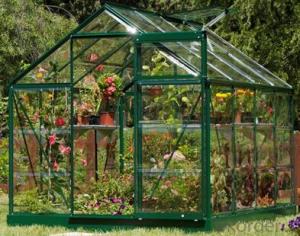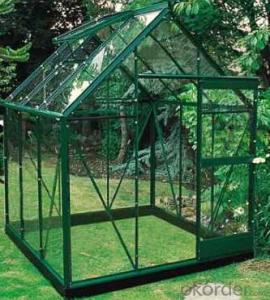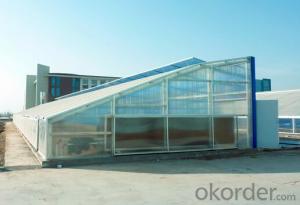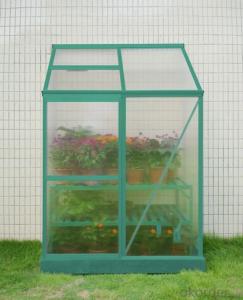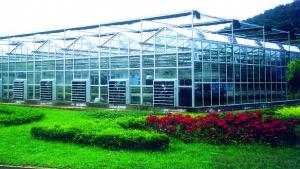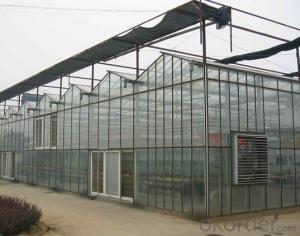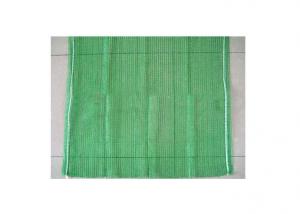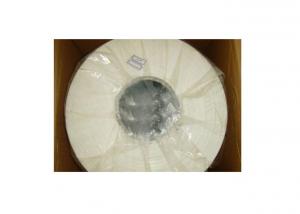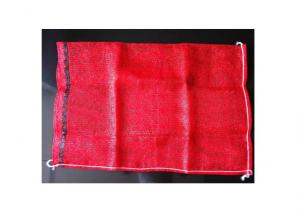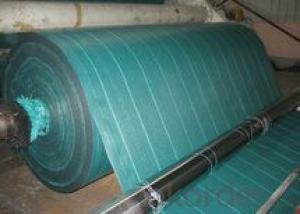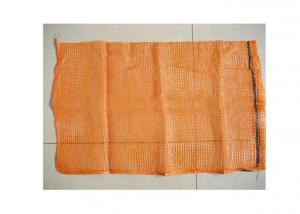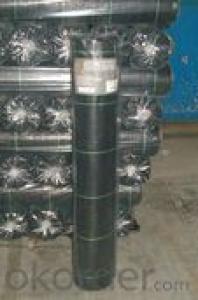High light transmission modular greenhouse for flower garden center
- Loading Port:
- Shanghai
- Payment Terms:
- TT OR LC
- Min Order Qty:
- 10 set
- Supply Capability:
- 1000 set/month
OKorder Service Pledge
OKorder Financial Service
You Might Also Like
Full range and customized of product
Ideal price-quality ratio
Satisfactory service from “A” to ”Z”
True quality guarantee
1.Feature:
Good heat retention, high intensity, easy assembly, energy saving, anti dew, strong impact resistance and long service life, etc
2.Structural Characteristics:
Venlo structure or A shape structure
span: 8m/9.6M/12M, bay size: 3.2M/ 4M, section :4M/ 4.5M;
Gutter: 3-5.5M
The frame works structure is assembled by prefabricated parts. All main parts are hot dipping galvanized after processing with zinc cover 275G/M2 in order to avoid any rust;
Cover: 8mm polycarbonate panel, by special aluminum profiles together with sealed band
Ventilation: single roof vents or double roof vents, controlled by rack and pinion system
Aluminum sliding doors;
- Q: Are agricultural plastic products used in biodegradable mulching?
- Yes, agricultural plastic products are used in biodegradable mulching.
- Q: This question asks about the methods farmers use to protect their crops from ultraviolet (UV) radiation using agricultural plastics.
- <p>Farmers protect their crops from UV radiation using agricultural plastics in several ways. They often use UV-stabilized plastic films in greenhouses and row covers. These films are designed to filter out harmful UV rays while still allowing other wavelengths of light necessary for photosynthesis to pass through. Additionally, farmers may apply UV-absorbing additives to plastic mulches, which can help to reduce the impact of UV radiation on the soil and plants. By managing the UV exposure, farmers can reduce crop damage, enhance growth conditions, and improve overall yield and quality.</p>
- Q: Are there nursery trays specifically designed for hydroponic systems?
- Yes, there are nursery trays specifically designed for hydroponic systems. These trays are typically made from durable materials, such as food-grade plastic, and have features like drainage holes or channels to allow for proper water circulation and nutrient absorption. They are designed to optimize plant growth and support the hydroponic system's unique requirements.
- Q: How do nursery trays help in seed germination?
- Nursery trays provide an ideal environment for seed germination by offering controlled conditions such as moisture, temperature, and protection. The trays allow for proper drainage, preventing waterlogging and root rot. They also provide support for the growing seedlings, allowing for easy transplanting once they have matured. Additionally, nursery trays help in optimizing space utilization and organization, ensuring efficient and successful seed germination.
- Q: How does ground cover impact the health of nearby trees?
- Ground cover can have a significant impact on the health of nearby trees. A healthy and appropriate ground cover can provide numerous benefits to trees, such as conserving soil moisture, reducing competition from weeds, regulating soil temperature, preventing erosion, and improving soil fertility. On the other hand, an inappropriate or dense ground cover can compete with trees for essential resources like sunlight, water, and nutrients, leading to stunted growth, nutrient deficiencies, and increased susceptibility to pests and diseases. Therefore, selecting the right ground cover is crucial for maintaining the overall health and well-being of nearby trees.
- Q: My mom is almost ddone with building her chicken coop. Now she is just putting on the finishing touches. She is wondering if chickens will nest in plastic boxes if they are cut right and such.
- For my nesty boxes I used old kitty litter boxes cat carriers set up on straw bales. The chickens seem to think they are good enough. I use regular straw for the floor. Once I made the mistake of thinking hay would be better as it smelled better, but it was much harder to clean didn't last as long as the straw when it came to keeping the smell down the droppings from sticking to the floor. I heard people complain that their Rhode Island roosters being aggressive toward them. You might want to check out temperment as each breed has it's own personality. You also have to go to reliable sources for this info, as people who breed a certain type are probably going to tell you they are 'OK' even if they aren't. I had problems with the Buckeye roosters being aggressive, but had no probs with Easter Eggers Isa Browns. The roosters don't use nesty boxes. Really the only time hens use the boxes is when they are laying eggs. I have a few hens that lay in the boxes at night, but 95% of them use roosts or sleep in the rafters. The guineas are VERY loud squawk a LOT. If you plan on having them sleep in the barn, you may get sick of them squacking every night when you go in there to lock the barn door. That's what happened to me.
- Q: I'm really into conserving the environment, and I've decided I'm going to try and do something about plastic shopping bags. In my city, the recycling place won't take plastic bags, because they aren't able to recycle them for some reason. I've found a site that taught me how to make plastic shopping bags into really good reusable ones, so I want to start making them. Basically I want to get a good statement that I can tell people about why re-usable is better.
- Plastic bags are non-biodegradable things means they don't mix with the soil . Where as cloth or jute bags are biodegradable means after use if you throw them , they automatically mix with soil after few days . Plastic bags some times chockes the sewage lines creating unhealthy cluster of sewage water which is the breeding places of many germs bacteria . They may out break any type of epidemics of diseases . Even the raper or cover of biscuits , or other things should be thrown here there . They should be put in garbage can , so that in garbage treatment plants , they can be separated for burning or recycling .
- Q: i have these red plastic/fake flowers that i want to put in my hair, but i really wish they were white. is there any way that i can bleach them or just remove the color somehow without ruining them? preferably with household products. thanks
- I'd suggest spray painting them as you cannot dye plastic. f they have stalks, leaves or anything you don't want white wrap/cover them in masking tape first. If your worried about the paint flaking off use a finishing spray or a vanish (matte or gloss depending on your tastes) If the flowers where clothe then a bleach would lighten them, not turn them white. I've tried doing that to an old red t-shirt. All id did was turn it pink.
- Q: Are agricultural plastic products harmful to plants or animals?
- Some agricultural plastic products can be harmful to plants and animals if not properly managed or disposed of. For example, plastic mulch films can leach chemicals into the soil, affecting plant growth and potentially harming beneficial organisms. Similarly, plastic debris in agricultural fields or water bodies can pose ingestion or entanglement risks to animals. However, if used responsibly and recycled or disposed of correctly, agricultural plastics can provide numerous benefits in terms of crop protection and resource conservation.
- Q: Can agricultural plastic products be used for animal bedding?
- Yes, agricultural plastic products can be used for animal bedding. They provide a cost-effective and durable option for bedding material, offering insulation, cushioning, and easy cleaning. However, it is important to ensure that the plastic used is non-toxic and safe for animals.
Send your message to us
High light transmission modular greenhouse for flower garden center
- Loading Port:
- Shanghai
- Payment Terms:
- TT OR LC
- Min Order Qty:
- 10 set
- Supply Capability:
- 1000 set/month
OKorder Service Pledge
OKorder Financial Service
Similar products
Hot products
Hot Searches
Related keywords
